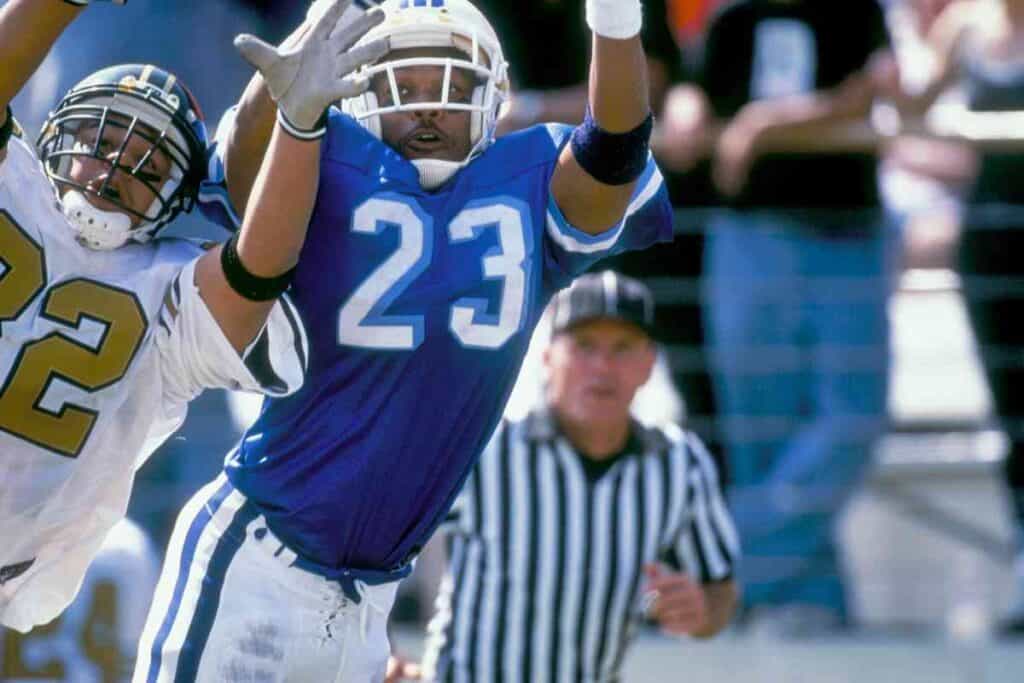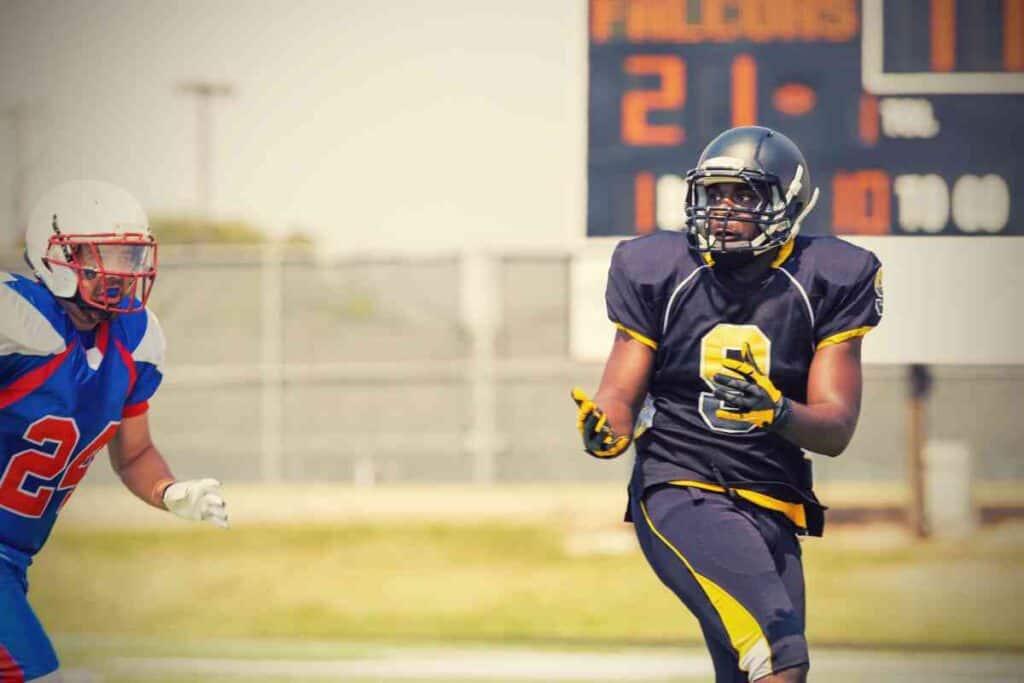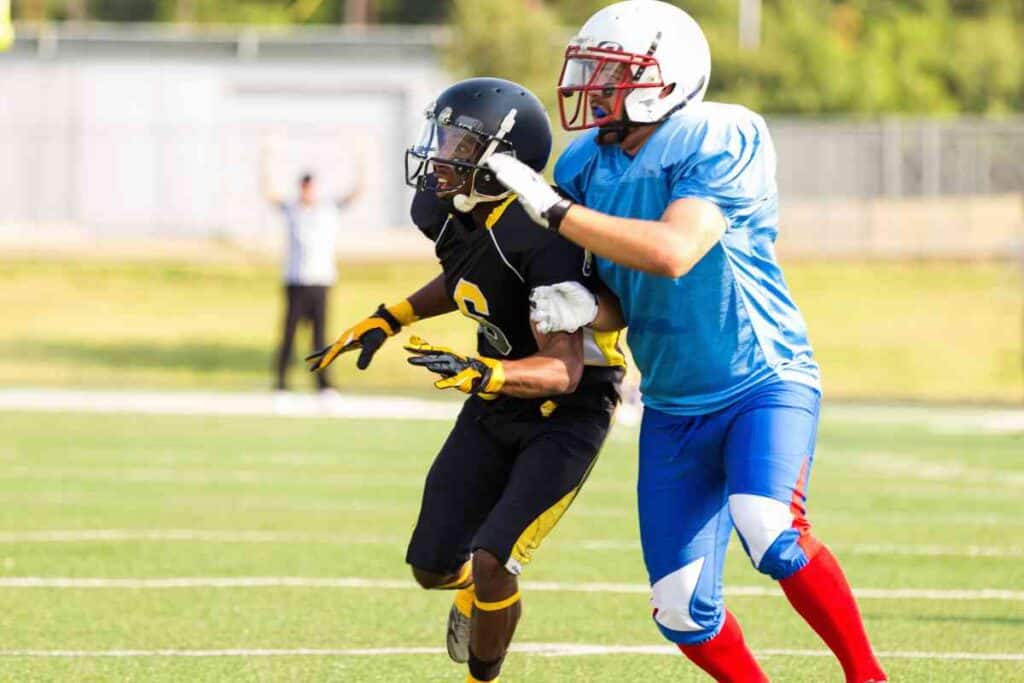Can You Face Guard In High School Football? The Surprising Answer!
High school football has some rules that govern how the offense and defense work. Can the defense face guard in high school football?

Can You Faceguard In High School Football?
Face guarding, which is defined as attempting to block the vision of a receiver using the hands without an attempt to look and find the ball, is allowed in high school. The penalty is the same as pass interference, which awards the offense 15 yards for the play.
We’ll give a detailed discussion about what face guarding is, and also talk about how the same rules are handled on different levels of competition.
What is face guarding in football?
The penalty isn’t talked about much in part because it blends in with the more commonly mentioned pass interference penalty that comes from contact while the ball is in the air.
Face guarding is a little different.
Instead of contact, face guarding involves a defender using their hands to block the vision of the intended receiver. The call is limited to face guarding when there is no contact made, but the defender is making no effort to go after the ball.
To see face guarding in action is a little more obvious: A defender who has his or her hands ready to run will have them at their sides or up in a position facing the quarterback to make a play on the ball.
It’s fairly obvious when the defender is simply attempting to block the field of view of the defender with their hands.

Can you face guard in high school football?
The rules regarding faceguarding have actually changed in the last few years. Up until 2017, face guarding was illegal in high school football. It is currently legal, bringing high school rules in line with college and NFL rules.
When watching football closely, you might notice that a defender’s hands tend to raise as they see a receiver turn around and try to look for the football.
To some, this isn’t so much an attempt to faceguard as it is a way to prepare the defender to tackle the receiver as soon as they receive the ball.
A fine lawn is drawn though: It is relatively difficult to face guard a player with your hands without touching them. Pass interference – when the defender makes contact with the receiver in an attempt to prevent them to catching the ball, is still illegal of course.
Why did the face guarding rule change?

The committee that makes changes to rules makes a few changes almost every year and doesn’t offer a specific explanation of why the rule changed.
While this is speculation, it is entirely possible that face guarding is actually difficult during a full-speed game and wasn’t called all that often, in addition to defenders generally attempting to play the ball anyway – or make contact and get flagged for pass interference.
Otherwise, no particular statistics are readily available that led to a change. Another motivation is that high school rules are now more in line with college and NFL rules, which provides fewer changes for players to make should they continue to play football competitively after high school.
We also believe that the skill level in high school is also high enough to overcome face-guarding. The receiver can outrun the defender and a good quarterback can play a ball where the receiver can see it.
In addition, attempting to block the receiver’s face only temporarily helps and doesn’t make much of an effort to create turnovens, which are more valuable than a missed pass.
Removing face guarding also simplifies pass interference: Pass interference is contact with the receiver while the ball is in the air.
Referees on the play don’t need to judge both, and the defense isn’t required to turn around in an effort to play the ball.
This is big when it comes to defenders running up to wide receivers during the catch because their helmets or other parts of their upper body could easily stop the ball.
What other changes have been made?

It seems that changing the rule for face-guarding didn’t exactly cause a big stir, in part because other, more important rules were changed in an effort to keep football players safe.
In 2017, the committee that heads and changes rules for high school football also added more definitions of a defenseless player. This attempts to avoid situations where a high school player can take a hard hit when they aren’t actually a ball carrier, like right after a catch.
Should high school football players try to face guard?
While the act of face guarding is now allowed, a defender who has the ability to keep up with a receiver and get their hands in a place to block their view is probably better of attacking the ball.
A slight misstep while attempting to faceguard can easily result in a pass interference or face masking penalty, and many receivers are talented enough to overcome attempts at faceguarding.
Key Takeaways
- Faceguarding, which is the act of a defender intentionally putting their hands in front of the face of a receiver without making contact, is legal in high school football.
- The decision to make face-guarding legal in high school football came a few years ago and was made in part to make high school rules more similar to college and NFL rules.
- The act used to result in a pass interference penalty but does not for now.
- Defenders still can’t make excessive physical contact with a receiver while the ball is in the air, or they will be penalized for pass interference.
